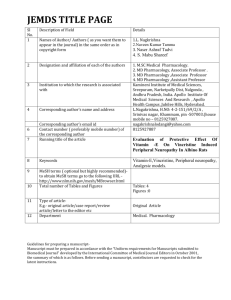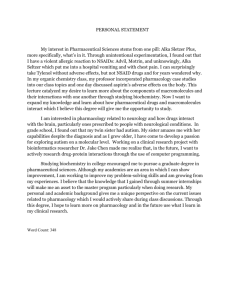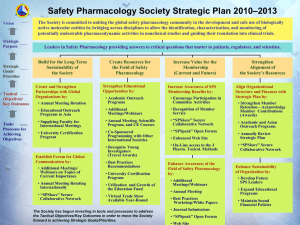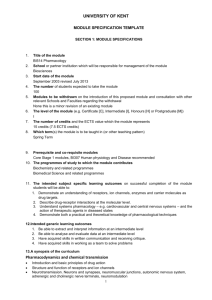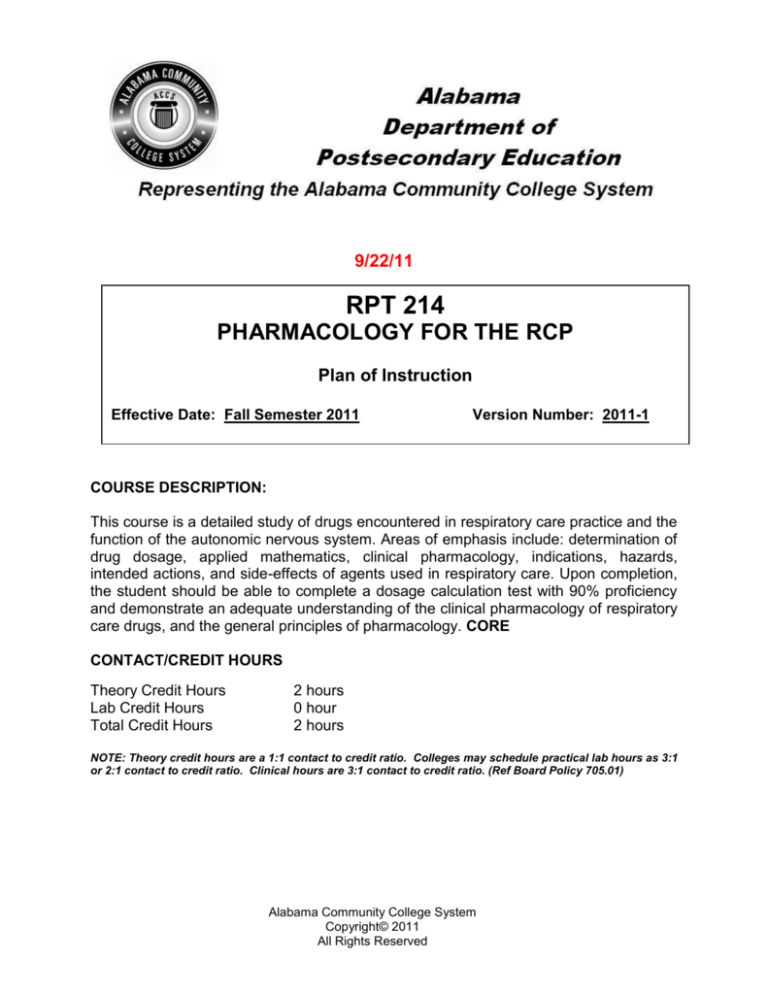
9/22/11
RPT 214
PHARMACOLOGY FOR THE RCP
Plan of Instruction
Effective Date: Fall Semester 2011
Version Number: 2011-1
COURSE DESCRIPTION:
This course is a detailed study of drugs encountered in respiratory care practice and the
function of the autonomic nervous system. Areas of emphasis include: determination of
drug dosage, applied mathematics, clinical pharmacology, indications, hazards,
intended actions, and side-effects of agents used in respiratory care. Upon completion,
the student should be able to complete a dosage calculation test with 90% proficiency
and demonstrate an adequate understanding of the clinical pharmacology of respiratory
care drugs, and the general principles of pharmacology. CORE
CONTACT/CREDIT HOURS
Theory Credit Hours
Lab Credit Hours
Total Credit Hours
2 hours
0 hour
2 hours
NOTE: Theory credit hours are a 1:1 contact to credit ratio. Colleges may schedule practical lab hours as 3:1
or 2:1 contact to credit ratio. Clinical hours are 3:1 contact to credit ratio. (Ref Board Policy 705.01)
Alabama Community College System
Copyright© 2011
All Rights Reserved
Pharmacology for the RCP
RPT 214
PREREQUISITE COURSES
As determined by college.
CO-REQUISITE COURSES
As determined by college.
PROFESSIONAL COMPETENCIES
Comprehend the fundamental principles of pharmacology.
Apply the fundamental principles of pharmacology to the treatment of respiratory
disorders.
Comprehend the clinical relevance of pharmacological principles in the critically
ill patient.
INSTRUCTIONAL GOALS
Cognitive – Comprehend principles and concepts related to clinical
pharmacology.
Psychomotor – Apply principles of pharmacology.
Affective – Value the importance of adhering to policies and procedures related
to principles of pharmacology.
STUDENT OBJECTIVES
Condition Statement: Unless otherwise indicated, evaluation of student’s attainment
of objectives is based on knowledge gained from this course. Specifications may be in
the form of, but not limited to, cognitive skills diagnostic instruments, manufacturer’s
specifications, technical orders, regulations, national and state codes, certification
agencies, locally developed lab/clinical assignments, or any combination of
specifications.
ACCS Copyright© 2011
All Rights Reserved
2
Pharmacology for the RCP
RPT 214
STUDENT LEARNING OUTCOMES
MODULE A – BASIC CONCEPTS AND PRINCIPALS OF PHARMACOLOGY
MODULE DESCRIPTION – The purpose of this module is to teach the foundational
principles of respiratory pharmacology. Topics include the drug classification and
approval process, three main principles of drug action, review of the central and peripheral
nervous system, systems of measurement, drug dosage calculations, and medical
terminology with most commonly used abbreviations.
PROFESSIONAL COMPETENCIES
PERFORMANCE OBJECTIVES
KSA
A1.0 Comprehend the fundamental
A1.1 This module is measured
2
principles of pharmacology.
cognitively
LEARNING OBJECTIVES
A1.1.1 Explain the process for drug classification and approval in the United
States.
A1.1.2 Discuss the key principles of drug action.
A1.1.3 Use the metric system to calculate drug doses, using proportions and
percentage-strength solutions.
A1.1.4 Identify and explain basic medical terms, abbreviations, and symbols.
KSA
1
1
2
2
MODULE A OUTLINE:
Pharmacology and the Study of Drugs
Naming Drugs
Sources of Drug Information
Sources of Drugs
Process of Drug Approval in the United States
o Chemical Isolation and Identification
o Animal Studies
o Investigational New Drug Approval
o New Drug Application
o Food and Drug Administration New Drug Classification System
o Orphan Drugs
The Prescription
o Over-the-counter Drugs
o Generic Substitution in Prescriptions
The Drug Administration Phase
o Drug Dosage Forms
o Routes of Administration
The Pharmacokinetic Phase
o Absorption
o Distribution
o Metabolism
o Elimination
o Pharmacokinetics of Inhaled Aerosol Drugs
The Pharmacodynamic Phase
ACCS Copyright© 2011
All Rights Reserved
3
Pharmacology for the RCP
RPT 214
o Structure–Activity Relations
o Nature and Type of Drug Receptors
o Dose–Response Relations
Pharmacogenetics
Systems of Measure
o The Metric System
o The International System of Units
o Drops as Units of Volume
o Household Units of Measure
Calculating Doses: Prepared-strength Liquids, Tablets, and Capsules
o Calculating With Proportions
o Drug Amounts in Units
o Examples of Calculations: Prepared-strength Drugs
Calculating Doses: Percentage-strength Solutions
o Types of Percentage Preparations
o Solutions by Ratio
o Solving Percentage-strength Solution Problems
o Diluents and Drug Doses
o Examples of Calculations With Solutions
Calculating Intravenous Infusion Rates
o Total Solution Over Time
o Amount of Drug per Unit of Time
o Additional Examples of Intravenous Dose Calculations
The Nervous System
o Anatomical Description of the Autonomic Branches
o Contrasts Between Parasympathetic and Sympathetic Regulation
o Neurotransmitters
o Efferent and Afferent Nerve Fibers
o Terminology of Drugs Affecting the Nervous System
Parasympathetic Branch
o Cholinergic Neurotransmitter Function
o Muscarinic and Nicotinic Receptors and Effects
o Subtypes of Muscarinic Receptors
Cholinergic Agents
o Direct-Acting Cholinergic Agents
o Indirect-Acting Cholinergic Agents
Anticholinergic Agents
o Atropine as a Prototype Parasympatholytic Agent
o Parasympatholytic (Antimuscarinic) Effects
Sympathetic Branch
o Adrenergic Neurotransmitter Function
o Sympathetic (Adrenergic) Receptor Types
o Sympathomimetic (Adrenergic) and Sympatholytic (Antiadrenergic) Agents
Neural Control of Lung Function
o Sympathetic Innervation and Effects
o Parasympathetic Innervation and Effects
ACCS Copyright© 2011
All Rights Reserved
4
Pharmacology for the RCP
RPT 214
MODULE B – DRUGS USED TO TREAT THE RESPIRATORY SYSTEM
MODULE DESCRIPTION – The purpose of this module is to emphasize the clinical
indications for drugs used to treat the respiratory system. These drugs are summarized by
their mechanism of action, structure, receptor selectivity and duration of action. Routes of
administration are discussed, along with a review of possible side effects.
PROFESSIONAL COMPETENCIES
PERFORMANCE OBJECTIVES
KSA
B1.0 Apply the fundamental
B1.1 This module is measured
3
principles of pharmacology to
cognitively.
the treatment of respiratory
disorders.
LEARNING OBJECTIVES
B1.1.1 Identify and discuss the categories of medications used to treat
respiratory disorders.
B1.1.2 Identify clinical indications for administering drugs used to treat the
respiratory system.
B1.1.3 Describe the mechanisms of action, use, and adverse effects of drugs
used in the treatment of the respiratory system.
B1.1.4 Identify the preferred pharmacologic agent for treating specific medical
disorders or diseases.
KSA
3
3
3
3
MODULE B OUTLINE:
A. Adrenergic (Sympathomimetic) Bronchodilators
Clinical Indications for Adrenergic Bronchodilators
o Indication for Short-Acting Agents
o Indication for Long-Acting Agents
o Indication for Racemic Epinephrine
Specific Adrenergic Agents and Formulations
o Catecholamines
o Resorcinol Agents
o Saligenin Agents
o Pirbuterol
o A Prodrug: Bitolterol
o Levalbuterol: The (R)-Isomer of Albuterol
o Long-Acting β-Adrenergic Agents
Mode of Action
o -Receptor and 2-Receptor Activation
o 1-Receptor Activation
o Salmeterol, Formoterol, and Arformoterol: Mechanism of Action
Routes of Administration
o Inhalation Route
o Oral Route
o Parenteral Route
ACCS Copyright© 2011
All Rights Reserved
5
Pharmacology for the RCP
RPT 214
Adverse Side Effects
B. Anticholinergic (Parasympatholytic) Bronchodilators
Clinical Indication for Use
o Indication for Anticholinergic Bronchodilator
o Indication for Combined Anticholinergic and -Agonist Bronchodilators
o Anticholinergic Nasal Spray
Specific Anticholinergic (Parasympatholytic) Agents
Clinical Pharmacology
o Structure–Activity Relations
o Pharmacological Effects of Anticholinergic (Antimuscarinic) Agents
Mode of Action
o Vagally Mediated Reflex Bronchoconstriction
o Muscarinic Receptor Subtypes
Adverse Side Effects
Clinical Application
o Use in Chronic Obstructive Pulmonary Disease
o Use in Asthma
o Combination Therapy: -Adrenergic and Anticholinergic Agents in Chronic
Obstructive Pulmonary Disease
C. Xanthines
Clinical Indications for the Use of Xanthines
o Use in Asthma
o Use in Chronic Obstructive Pulmonary Disease
o Use in Apnea of Prematurity
Specific Xanthine Agents
General Pharmacological Properties
o Structure–Activity Relations
o Proposed Theories of Activity
o Conclusion
Titrating Theophylline Doses
o Equivalent Doses of Theophylline Salts
o Serum Levels of Theophylline
o Dosage Schedules
Theophylline Toxicity and Side Effects
Factors Affecting Theophylline Activity
Clinical Uses
o Use in Asthma
o Use in Chronic Obstructive Pulmonary Disease
o Nonbronchodilating Effects of Theophylline
o Use in Apnea of Prematurity
D. Mucus-Controlling Drug Therapy
Clinical Indication for Use
o Identification of Agents
o Physiology of the Mucociliary System
ACCS Copyright© 2011
All Rights Reserved
6
Pharmacology for the RCP
RPT 214
Factors Affecting Mucociliary Transport
Nature of Mucus Secretion
o Structure and Composition of Mucus
o Mucus in Disease States
o Physical Properties of Mucus
Mucoactive Agents
o Mucolysis and Mucociliary Clearance
o Mucolytics and Expectorants
N-Acetyl-L-cysteine (NAC)
o Indications for Use
o Mode of Action
o Hazards
Dornase Alfa (Pulmozyme)
o Indication and Use in Cystic Fibrosis
o Mode of Action
o Dose and Administration
o Adverse Effects
o Clinical Application and Evaluation
Expectorants
o Iodide-containing Agents
o Sodium Bicarbonate
o Guaifenesin
o Dissociating Solvents
o Oligosaccharides
o P2Y2 Agonists
Mucokinetic Agents
Other Mucoactive Agents
o Antiproteases
o Hyperosmolar Saline
E. Corticosteroids
Clinical Indications for Use of Inhaled Corticosteroids
Identification of Aerosolized Corticosteroids
Physiology of Corticosteroids
o Identification and Source
o The Hypothalamic–Pituitary–Adrenal Axis
o Hypothalamic–Pituitary–Adrenal Suppression With Steroid Use
o The Diurnal Steroid Cycle
o Alternate-day Steroid Therapy
Nature of the Inflammatory Response
o Inflammation
o Inflammation in the Airway
Aerosolized Corticosteroids
Intranasal Corticosteroids
Pharmacology of Corticosteroids
o Mode of Action
o Effect on White Blood Cell Count
ACCS Copyright© 2011
All Rights Reserved
7
Pharmacology for the RCP
RPT 214
o Effect on Receptors
Hazards and Side Effects of Steroids
o Systemic Administration of Steroids
o Systemic Side Effects With Aerosol Administration
o Topical (Local) Side Effects With Aerosol Administration
Clinical Application of Aerosol Steroids
o Use in Asthma
o Use in Chronic Obstructive Pulmonary Disease
F. Nonsteroidal Antiasthma Agents
Clinical Indication for Nonsteroidal Antiasthma Agents
Identification of Nonsteroidal Antiasthma Agents
Mechanisms of Inflammation in Asthma
The Immunological (Allergic) Response
o Cromolyn-like (Mast Cell–stabilizing) Agents
Cromolyn Sodium (Disodium Cromoglycate)
Nedocromil Sodium (Tilade)
o Antileukotriene Agents
Leukotrienes and Inflammation
Zileuton (Zyflo)
Zafirlukast (Accolate)
Montelukast (Singulair)
Role of Antileukotriene Drugs in Asthma Management
Monoclonal Antibodies
G. Aerosolized Antiinfective Agents
Clinical Indications for Aerosolized Antiinfective Agents
Identification of Aerosolized Antiinfective Agents
o Aerosolized Pentamidine
Introduction of Aerosolized Pentamidine (NebuPent)
Dosage and Administration
Mode of Action
Side Effects
o Ribavirin
Clinical Use
Respiratory Syncytial Virus Infection
Dosage and Administration
Mode of Action
Side Effects
Respiratory Syncytial Virus Immune Globulin Intravenous
(Human)-RespiGam
Palivizumab (Synagis)
o Aerosolized Tobramycin
Clinical Use of Inhaled Tobramycin
Dosage and Administration
Mode of Action
Side Effects
o Inhaled Zanamivir
ACCS Copyright© 2011
All Rights Reserved
8
Pharmacology for the RCP
RPT 214
Clinical Use of Inhaled Zanamivir (Relenza)
Dosage and Administration
Mode of Action
Adverse Effects
H. Antimicrobial Agents
Principles of Antimicrobial Therapy
o Identification of the Pathogen
o Susceptibility Testing and Resistance
o Host Factors
o Pharmacodynamics
o Antimicrobial Combinations
o Monitoring Response to Therapy
Antibiotics
o Penicillins
o Cephalosporins
o Carbapenems
o Monobactams (Aztreonam)
o Aminoglycosides
o Tetracyclines
o Tigecycline
o Macrolides
o Telithromycin
o Quinolones (Fluoroquinolones)
o Other Antibiotics
Antimycobacterials
o Isoniazid
o Rifampin and Rifabutin
o Pyrazinamide
o Ethambutol
o Streptomycin
Antifungals
o Polyenes
o Azoles
o Echinocandins
o Flucytosine
o Griseofulvin and Terbinafine
Antiviral Agents
o Acyclovir and Valacyclovir
o Penciclovir and Famciclovir
o Ganciclovir and Valganciclovir
o Cidofovir
o Foscarnet
o Fomivirsen
o Amantadine and Rimantadine
o Oseltamivir
ACCS Copyright© 2011
All Rights Reserved
9
Pharmacology for the RCP
RPT 214
MODULE C – CRITICAL CARE AND CARDIOVASCULAR DRUGS
MODULE DESCRIPTION – The purpose of this module is to emphasize the clinical
application of pharmacology in patients with life-threatening injuries and illnesses. Special
consideration is given to drugs used to treat the cardiovascular system.
PROFESSIONAL COMPETENCIES
PERFORMANCE OBJECTIVES
KSA
C1.0 Comprehend the clinical
C1.1 This module is measured
3
relevance of pharmacological
cognitively.
principles in the critically ill
patient.
LEARNING OBJECTIVES
C1.1.1 Discuss the practical and philosophical approach to critical care
pharmacology.
C1.1.2 Discuss the different pharmacological agents used in critically ill patients.
C1.1.3 Apply physiological knowledge to interpret changes that occur due to
injuries incurred during the perioperative period and in critical illness.
C1.1.4 Identify various effects of medications on the central nervous system
MODULE C OUTLINE:
A. Skeletal Muscle Relaxants
Uses of Neuromuscular Blocking Agents
Physiology of the Neuromuscular Junction
Nondepolarizing Agents
o Mode of Action
o Pharmacokinetics of Nondepolarizing Agents
o Metabolism
o Adverse Effects and Hazards
o Reversal of Nondepolarizing Blockade
Depolarizing Agents
o Mode of Action
o Metabolism
o Reversal
o Adverse Effects and Hazards
Neuromuscular Blocking Agents and Mechanical Ventilation
o Precautions and Risks
o Use of Sedation and Analgesia
o Interactions With Neuromuscular Blocking Agents
o Choice of Agents
Monitoring of Neuromuscular Blockade
B. Vasopressors, Inotropes, and Antiarrhythmic Agents
Cardiovascular Review
o Electrophysiology of the Myocardium
Agents Used in the Management of Shock
Pharmacology of Antiarrhythmics
o Class IA
ACCS Copyright© 2011
All Rights Reserved
KSA
2
2
3
3
10
Pharmacology for the RCP
RPT 214
o Class IB
o Class IC
o Class II
o Class III
o Class IV
o Miscellaneous Agents
Management and Pharmacotherapy of Advanced Cardiac Life Support
o Epinephrine
o Vasopressin (Pitressin)
o Atropine (AtroPen)
o Sodium Bicarbonate
o Magnesium Sulfate
C. Drugs Affecting Circulation
Epidemiology and Etiology of Hypertension
o Pathophysiology of Hypertension
o Hypertensive Crisis
o Hypertension Pharmacotherapy
Angiotensin-Converting Enzyme Inhibitors
Angiotensin II Receptor Blockers
Calcium Channel Blockers
Diuretics
Aldosterone Antagonists
Centrally Acting Adrenergic Agents
1-Adrenergic Antagonists
Antiadrenergic Agents
Vasodilators
Epidemiology, Etiology, and Pathophysiology of Angina
o Pharmacotherapy for Angina
o Nitrates
o Ranolazine
Antithrombotic Agents
o Anticoagulant Agents
o Antiplatelet Agents
o Thrombolytic Agents
D. Diuretics
Renal Structure and Function
o Glomerular Filtration
o Electrolyte Filtration and Reabsorption
o Acid–Base Balance
Diuretic Groups
o Osmotic Diuretics
o Carbonic Anhydrase Inhibitors
o Loop Diuretics
o Thiazide Diuretics
o Potassium-Sparing Diuretics
ACCS Copyright© 2011
All Rights Reserved
11
Pharmacology for the RCP
RPT 214
Adverse Effects
o Hypovolemia
o Hypokalemia
o Acid–Base Disorders
o Glucose Changes
o Ototoxicity
E. Drugs Affecting the Central Nervous System
Neurotransmitters
Psychiatric Medications
o Antidepressants
o Mood Stabilizers
o Antipsychotics
o Drugs for Alzheimer’s Dementia: Cholinesterase Inhibitors
o Anxiolytics
o Barbiturates
o Other Hypnotics
Ethyl Alcohol
Pain Treatment
o Nonsteroidal Antiinflammatory Drugs
o Opioid Analgesics
o Routes of Opioid Administration
o Opioid Inhalation
o Local Anesthetics
o Epidural Analgesia
o Combinations of Analgesic Classes
Chronic Pain Syndromes
Anesthesia
o Conscious Sedation
o Central Nervous System and Respiratory Stimulants
ACCS Copyright© 2011
All Rights Reserved
12
Pharmacology for the RCP
RPT 214
LEARNING OUTCOMES TABLE OF SPECIFICATIONS
The table below identifies the percentage of learning objectives for each module.
Instructors should develop sufficient numbers of test items at the appropriate
level of evaluation.
Limited
Knowledge and
Proficiency
Module A
Module B
Module C
ACCS Copyright© 2011
All Rights Reserved
1
50%
Moderate
Knowledge
and
Proficiency
2
50%
50%
Advanced
Knowledge
and
Proficiency
3
Superior
Knowledge
and
Proficiency
4
100%
50%
13
Pharmacology for the RCP
Indicator
1
2
3
4
RPT 214
Learner’s Knowledge, Skills and Abilities
Key Terms
Description
Identifies basic facts and terms about the subject or
competency.
Limited
Knowledge Performs simple tasks associated with the
and
competency. Needs to be told or shown how to do
Proficiency
most tasks.
Requires close supervision.
Identifies relationship of basic facts and states
general principles and can determine step-by-step
Moderate
procedures for doing the competency.
Knowledge
and
Performs most parts of the competency. Needs help
Proficiency
only on hardest parts.
Requires limited supervision.
Analyzes facts and principles and draws conclusions
about the subject to include why and when the
Advanced
competency must be done and why each step is
Knowledge
needed. Can predict outcomes.
and
Performs all parts of the competency. Needs only a
Proficiency
spot check of completed work.
Requires little or no direct supervision.
Can evaluate conditions and make appropriate
Superior
decisions as related to resolving problems.
Knowledge
Performs competency quickly and accurately with no
and
direct supervision and is able to instruct and
Proficiency
supervise others.
ACCS Copyright© 2011
All Rights Reserved
14



